Enhanced Adsorption of Azoxystrobin from Water by As-Prepared Silica Nanoparticles
Abstract
:1. Introduction
2. Materials and Methods
2.1. Materials
2.2. Synthesis of Silica Nanoparticles
2.3. Characterization
2.4. Utilization of Nano-Particles in the Removal of Azoxystrobin
2.4.1. Effect of Contact Time
2.4.2. Effect of Initial Concentration of Azoxystrobin
2.4.3. Effect of Adsorbent Mass
2.4.4. Effect of Temperature
2.5. Regeneration and Reusability
2.6. HPLC-DAD
3. Results
3.1. Particle Size
3.2. Surface Area Evaluation
3.3. Surface Characterization
3.4. XRD Analysis of SiO2 Nanoparticles
3.5. Adsorption Studies
3.5.1. Adsorbent Dose Influence
3.5.2. Influence of Azoxystrobin Initial Concentration
3.5.3. The Influence of Temperature
3.5.4. Regeneration and Reuse Study
3.6. Isothermal and Kinetic Studies of Adsorption Processes
4. Conclusions
Author Contributions
Funding
Institutional Review Board Statement
Informed Consent Statement
Data Availability Statement
Conflicts of Interest
References
- Wang, W.; Martin, J.C.; Zhang, N.; Ma, C.; Han, A.; Sun, L. Harvesting silica nanoparticles from rice husks. J. Nano Part Res. 2011, 13, 6981–6990. [Google Scholar] [CrossRef]
- Chandrasekhar, S.; Pramada, P.N.; Raghavan, P.; Satyanrayana, K.G. Micro silica from rice husk as a possible substitute for condensed silica fume for high-performance concrete. J. Mater. Sci. Lett. 2002, 21, 1245–1247. [Google Scholar] [CrossRef]
- Mader, H.; Li, X.; Saleh, S.; Link, M.; Kele, P.; Wolfbeis, O.S. Fluorescent silica nanoparticles. Ann. N. Y. Acad. Sci. 2008, 1130, 218–223. [Google Scholar] [CrossRef] [PubMed]
- Ali, R.; Saleh, S.M.; Elshaarawy, R.F. Turn-on pH nano-fluorosensor based on imidazolium salicylaldehyde ionic liquid-labeled silica nanoparticles. RSC Adv. 2016, 6, 86965–86975. [Google Scholar] [CrossRef]
- Saleh, S.M.; Müller, R.; Mader, H.S.; Duerkop, A.; Wolfbeis, O.S. Novel multicolor fluorescently labeled silica nanoparticles for interface fluorescence resonance energy transfer to and from labeled avidin. Anal. Bioanal. Chem. 2010, 398, 1615–1623. [Google Scholar] [CrossRef]
- Saleh, S.M.; Alminderej, F.M.; Ali, R.; Abdallah, O.I. Optical sensor film for metribuzin pesticide detection. Spectrochim. Acta A Mol. Biomol. Spectrosc. 2020, 229, 117971. [Google Scholar] [CrossRef]
- Zhang, W.; Ma, M.; Zhang, X.A.; Zhang, Z.Y.; Saleh, S.M.; Wang, X.D. Fluorescent proteins as efficient tools for evaluating the surface PEGylation of silica nanoparticles. Methods Appl. Fluoresc. 2017, 5, 024003. [Google Scholar] [CrossRef]
- Mellaerts, R.; Houthoofd, K.; Elen, K.; Chen, H.; Van Speybroeck, M.; Van Humbeeck, J.; Augustijns, P.; Mullens, J.; Van den Mooter, G.; Martens, J.A. Aging behavior of pharmaceutical formulations of itraconazole on SBA-15 ordered mesoporous silica carrier material. Microporous Mesoporous Mater. 2010, 130, 154–161. [Google Scholar] [CrossRef]
- Hou, P.; Kawashima, S.; Kong, D.; Corr, D.J.; Qian, J.; Shah, S.P. Modification effects of colloidal nanoSiO2 on cement hydration and its gel property. Compos. Part B Eng. 2016, 45, 440–448. [Google Scholar] [CrossRef] [Green Version]
- Youssif, M.I.; El-Maghraby, R.M.; Saleh, S.M.; Elgibaly, A.A. Sol–Gel Tailored Synthesized Nanosilica for Enhanced Oil Recovery in Water-Wet and Oil-Wet Benthemier Sandstone. Energy Fuel. 2018, 32, 12373–12382. [Google Scholar] [CrossRef]
- Saleh, S.; Younis, A.; Ali, R.; Elkady, E. Phenol removal from aqueous solution using amino-modified silica nanoparticles. Korean J. Chem. Eng. 2019, 36, 529–539. [Google Scholar] [CrossRef]
- Pajonk, G.M. Some applications of silica aerogels. Colloid Polym. Sci. 2003, 281, 637–651. [Google Scholar] [CrossRef]
- Chuiko, A.A. Medical Chemistry and Clinical Application of Silicon Dioxide; Nukova Dumka: Kiev, Ukraine, 2003. [Google Scholar]
- Saleh, S.M.; Ali, R.; Wolfbeis, O.S. New silica, and polystyrene nanoparticles labeled with longwave absorbing and fluorescent chameleon dyes. Microchim. Acta 2011, 174, 429–434. [Google Scholar] [CrossRef]
- Youssif, M.I.; El-Maghraby, R.M.; Saleh, S.M.; Elgibaly, A. Silica nanofluid flooding for enhanced oil recovery in sandstone rocks. Egypt. J. Pet. 2018, 27, 105–110. [Google Scholar] [CrossRef]
- Kumar, M.N.V.; Sameti, M.; Mohapatra, S.S.; Kong, X.; Lockey, R.F.; Bakowsky, U.; Lindenblatt, G.; Schmidt, C.H.; Lehr, C.-M. Cationic silica nanoparticles as gene carriers: Synthesis, characterization and transfection efficiency in vitro and in vivo. J. Nano Sci. Nano Technol. 2004, 4, 876–881. [Google Scholar] [CrossRef] [PubMed]
- Younis, A.M.; Elkady, E.M.; Saleh, S.M. Novel eco-friendly amino-modified nanoparticles for phenol removal from aqueous solution. Environ. Sci. Pollut. Res. 2020, 27, 30694–30705. [Google Scholar] [CrossRef]
- Moghimi, S.M.; Hunter, A.C.; Murray, J.C. Nanomedicine: Current status and prospects. FASEB J. 2005, 19, 311–330. [Google Scholar] [CrossRef] [Green Version]
- Slowing, I.I.; Trewyn, B.G.; Giri, S.; Lin, V.S.Y. Mesoporous silica nanoparticles for drug delivery and biosensing applications. Adv. Funct. Mater. 2007, 17, 1225–1236. [Google Scholar] [CrossRef]
- Slowing, I.I.; Vivero-Escoto, J.L.; Wu, C.W.; Lin, V.S. Mesoporous silica nanoparticles as controlled release drug delivery and gene transfection carriers. Adv. Drug Deliv. Rev. 2008, 60, 1278–1288. [Google Scholar] [CrossRef]
- Gurav, J.L.; Jung, I.K.; Park, H.H.; Kang, E.S.; Nadargi, D.Y. Silica aerogel: Synthesis and applications. J. Nanomater. 2010, 2010, 409310. [Google Scholar] [CrossRef] [Green Version]
- Napierska, D.; Thomassen, L.C.; Lison, D.; Martens, J.A.; Hoet, P.H. The nano-silica hazard: Another variable entity. Part. Fibre Toxicol. 2010, 7, 39. [Google Scholar] [CrossRef] [PubMed] [Green Version]
- Shin, Y.; Lee, D.; Lee, K.; Ahn, K.H.; Kim, B. Surface properties of silica nanoparticles modified with polymers for polymer nanocomposite applications. J. Ind. Eng. Chem. 2008, 14, 515–519. [Google Scholar] [CrossRef]
- Zou, H.; Wu, S.; Shen, J. Polymer/silica nanocomposites: Preparation, characterization, properties, and applications. Chem. Rev. 2008, 108, 3893–3957. [Google Scholar] [CrossRef]
- Subbiah, R.; Veerapandian, M.; Yun, K.S. Nanoparticles: Functionalization and multifunctional applications in biomedical sciences. Curr. Med. Chem. 2010, 17, 4559–4577. [Google Scholar] [CrossRef] [PubMed]
- Bhagiyalakshmi, M.; Yun, L.J.; Anuradha, R.; Jang, H.T. Utilization of rice husk ash as silica source for the synthesis of mesoporous silicas and their application to CO2 adsorption through TREN/TEPA grafting. J. Hazard Mater. 2010, 175, 928–938. [Google Scholar] [CrossRef]
- Rahman, I.A.; Padavettan, V. Synthesis of silica nanoparticles by Sol-gel: Size-dependent Properties, Surface Modification and Applications in Silica-Polymer Nanocomposites—A Review. J. Nanomater. 2012, 2012, 132424. [Google Scholar] [CrossRef] [Green Version]
- Bernardos, A.; Kourimska, L. Applications of Mesoporous Silica Materials in Food—A Review. Czech J. Food Sci. 2013, 31, 99–107. [Google Scholar] [CrossRef] [Green Version]
- Hassan, A.F.; Abdelghny, A.M.; Elhadidy, H.; Youssef, A.M. Synthesis and characterization of high surface area nano silica from rice husk ash by surfactant-free sol-gel method. J. Sol-Gel Sci. Technol. 2014, 69, 465–472. [Google Scholar] [CrossRef]
- Brinker, C.J.; Scherer, G.W. Sol-Gel Science: The Physics and Chemistry of Sol-Gel Processing; Academic Press Inc.: San Diego, CA, USA, 1990; p. 907. [Google Scholar]
- Amirhandeh, S.Z.H.; Salem, A.; Salem, S. Treatment of tannery wastewater by silica nanoparticles produced from rice husk ash via a green route. Environ. Sci. Pollut. Res. Int. 2023, 30, 13039–13047. [Google Scholar] [CrossRef]
- Gehrke, I.; Geiser, A.; Somborn-Schulz, A. Innovations in nanotechnology for water treatment. Nanotechnol. Sci. Appl. 2015, 8, 1–17. [Google Scholar] [CrossRef] [Green Version]
- Sharma, P.; Prakash, J.; Kaushal, R. An insight into the green synthesis of SiO2 nanostructures as a novel adsorbent for removal of toxic water pollutants. Environ. Res. 2022, 212, 113328. [Google Scholar] [CrossRef] [PubMed]
- Ui, S.W.; Lim, S.J.; Lee, S.H.; Choi, S.C. Control of the size and morphology of nano-size silica particles using a sodium silicate solution. J. Ceram. Process. Res. 2009, 10, 553–558. [Google Scholar]
- Mushtaq, N.; Singh, D.V.; Bhat, R.A.; Dervash, M.A.; Hameed, O.B. Freshwater contamination: Sources and hazards to aquatic biota. Freshw. Pollut. Dyn. Remediat. 2020, 27–50. [Google Scholar] [CrossRef]
- Manasa, R.L.; Mehta, A. Wastewater: Sources of pollutants and its remediation. Environ. Biotechnol. 2020, 2, 197–219. [Google Scholar]
- Vela, N.; Fenoll, J.; Garrido, I.; Pérez-Lucas, G.; Flores, P.; Hellín, P.; Navarro, S. Reclamation of agro-wastewater polluted with pesticide residues using sunlight activated persulfate for agricultural reuse. Sci. Total Environ. 2019, 660, 923–930. [Google Scholar] [CrossRef]
- Sutherland, D.L.; Ralph, P.J. Microalgal bioremediation of emerging contaminants-opportunities and challenges. Water Res. 2019, 164, 114921. [Google Scholar] [CrossRef]
- Nguyen, X.H.; Tran, N.A.; Nguyen, T.T.H.; Dao, T.T.N. Nanosilica synthesis and application for lead treatment in water. J. Vietnam. Environ. 2018, 9, 255–263. [Google Scholar] [CrossRef]
- Srivastava, A.; Kumari, M.; Ramanathan, A.; Selvaraj, K.; Prasad, B.; Prasad, K.S. Removal of fluoride from aqueous solution by mesoporous silica nanoparticles functionalized with chitosan derived from mushroom. J. Macromol. Sci. Part A 2020, 9, 619–627. [Google Scholar] [CrossRef]
- Yao, J.; Cui, B.; Zhao, X.; Zhi, H.; Zeng, Z.; Wang, Y.; Sun, C.; Liu, G.; Gao, J.; Cui, H. Antagonistic effect of azoxystrobin poly (lactic acid) microspheres with controllable particle size on Colletotrichum higginsianum Sacc. Nanomaterials 2018, 8, 857. [Google Scholar] [CrossRef] [Green Version]
- Wang, X.; Wang, H.; Lu, M.; Teng, R.; Du, X. Facile synthesis of phenyl-modified magnetic graphene/mesoporous silica with hierarchical bridge-pore structure for efficient adsorption of pesticides. Mater. Chem. Phys. 2017, 198, 393–400. [Google Scholar] [CrossRef]
- Wanjeri, V.W.O.; Sheppard, C.J.; Prinsloo, A.R.E.; Ngila, J.C.; Ndungu, P.G. Isotherm and kinetic investigations on the adsorption of organophosphorus pesticides on graphene oxide based silica-coated magnetic nanoparticles functionalized with 2-phenylethylamine. J. Environ. Chem. Eng. 2018, 6, 1333–1346. [Google Scholar] [CrossRef]
- Chaudhary, S.; Sharma, P.; Kaur, A.; Kumar, R.; Mehta, S.K. Surfactant coated silica nanoparticles as smart scavengers for adsorptive removal of naphthalene. J. Nanosci. Nanotechnol. 2018, 18, 3218–3229. [Google Scholar] [CrossRef] [PubMed]
- Wang, T.; Ai, S.; Zhou, Y.; Luo, Z.; Dai, C.; Yang, Y.; Luo, L. Adsorption of agricultural wastewater contaminated with antibiotics, pesticides, and toxic metals by functionalized magnetic nanoparticles. J. Environ. Chem. Eng. 2018, 6, 6468–6478. [Google Scholar] [CrossRef]
- Massad, Y.; Hanbali, G.; Jodeh, S.; Hamed, O.; Bzour, M.; Dagdag, O.; Samhan, S. The efficiency of removal of organophosphorus malathion pesticide using functionalized multi-walled carbon nanotube: Impact of Dissolved Organic Matter (DOM). Sep. Sci. Technol. 2022, 57, 1–12. [Google Scholar] [CrossRef]
- Shrivas, K.; Ghosale, A.; Nirmalkar, N.; Srivastava, A.; Singh, S.K.; Shinde, S.S. Removal of endrin and dieldrin isomeric pesticides through stereoselective adsorption behavior on the graphene oxide-magnetic nanoparticles. Environ. Sci. Pollut. Res. 2017, 24, 24980–24988. [Google Scholar] [CrossRef]
- Yang, Q.; Wang, J.; Zhang, W.; Liu, F.; Yue, X.; Liu, Y.; Wang, J. Interface engineering of metal-organic framework on graphene oxide with enhanced adsorption capacity for organophosphorus pesticide. Chem. Eng. J. 2017, 313, 19–26. [Google Scholar] [CrossRef]
- Hameed, B.H.; Rahman, A.A. Removal of phenol from aqueous solutions by adsorption onto activated carbon prepared from biomass material. J. Hazard. Mater. 2008, 160, 576–581. [Google Scholar] [CrossRef]
- Yuh-Shan, H. Citation review of Lagergren kinetic rate equation on adsorption reactions. Scientometrics 2004, 59, 171–177. [Google Scholar] [CrossRef]
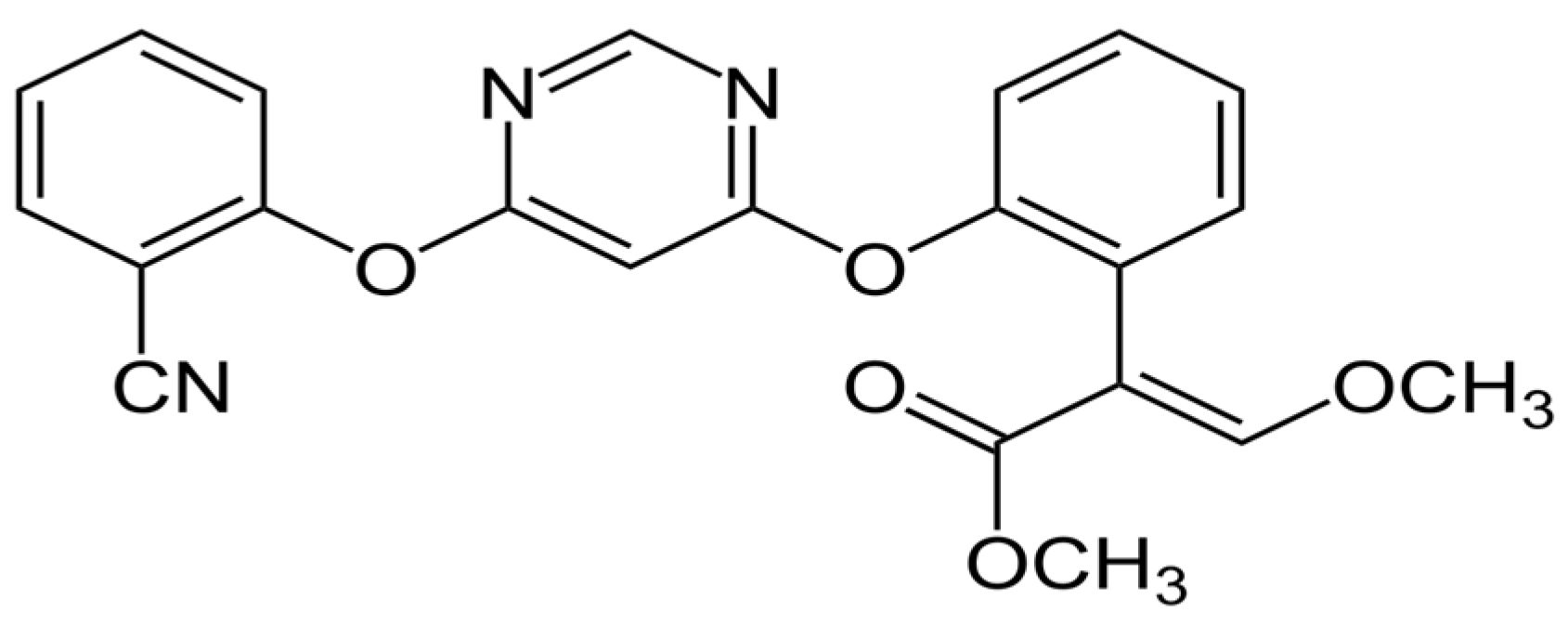

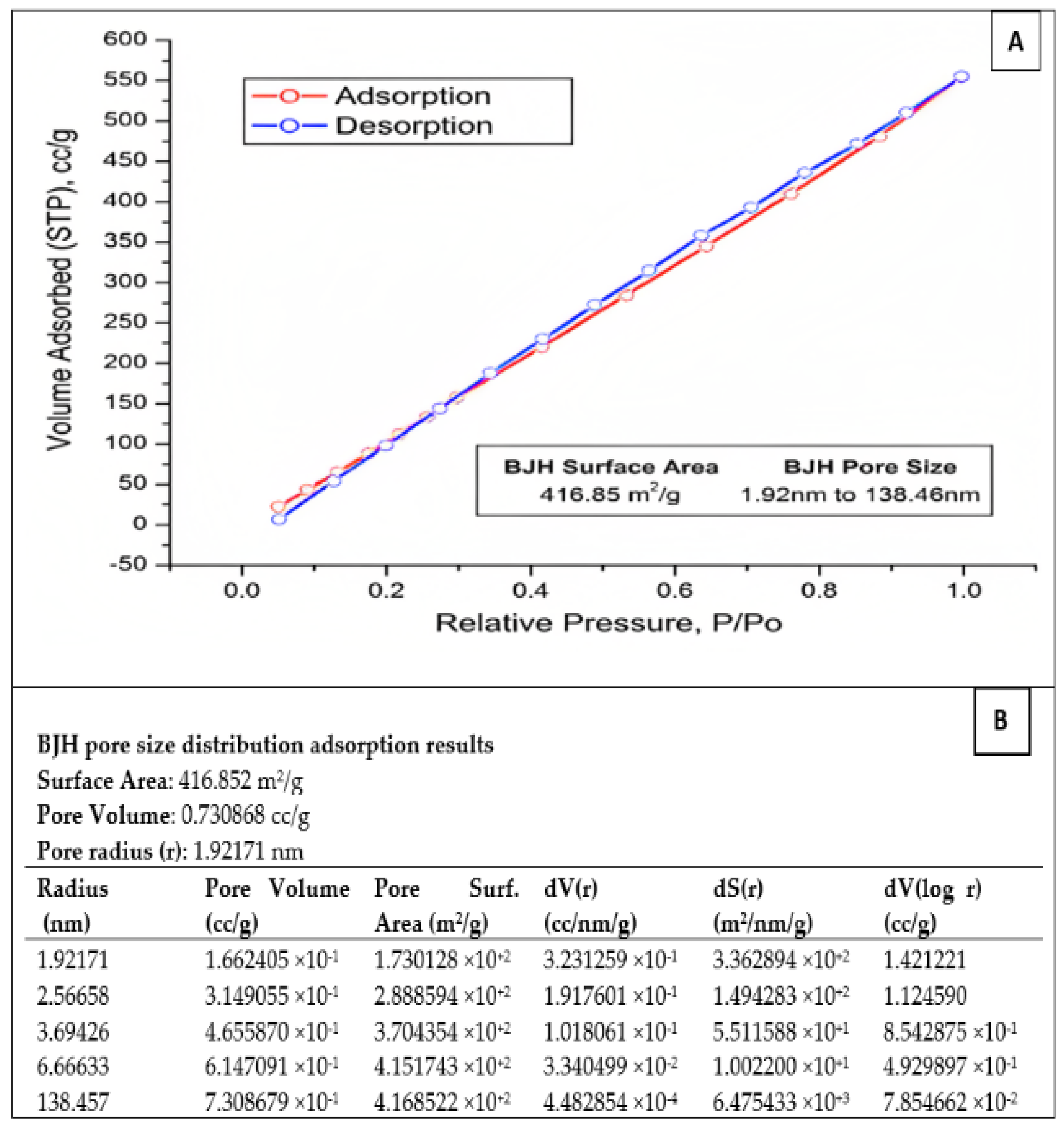
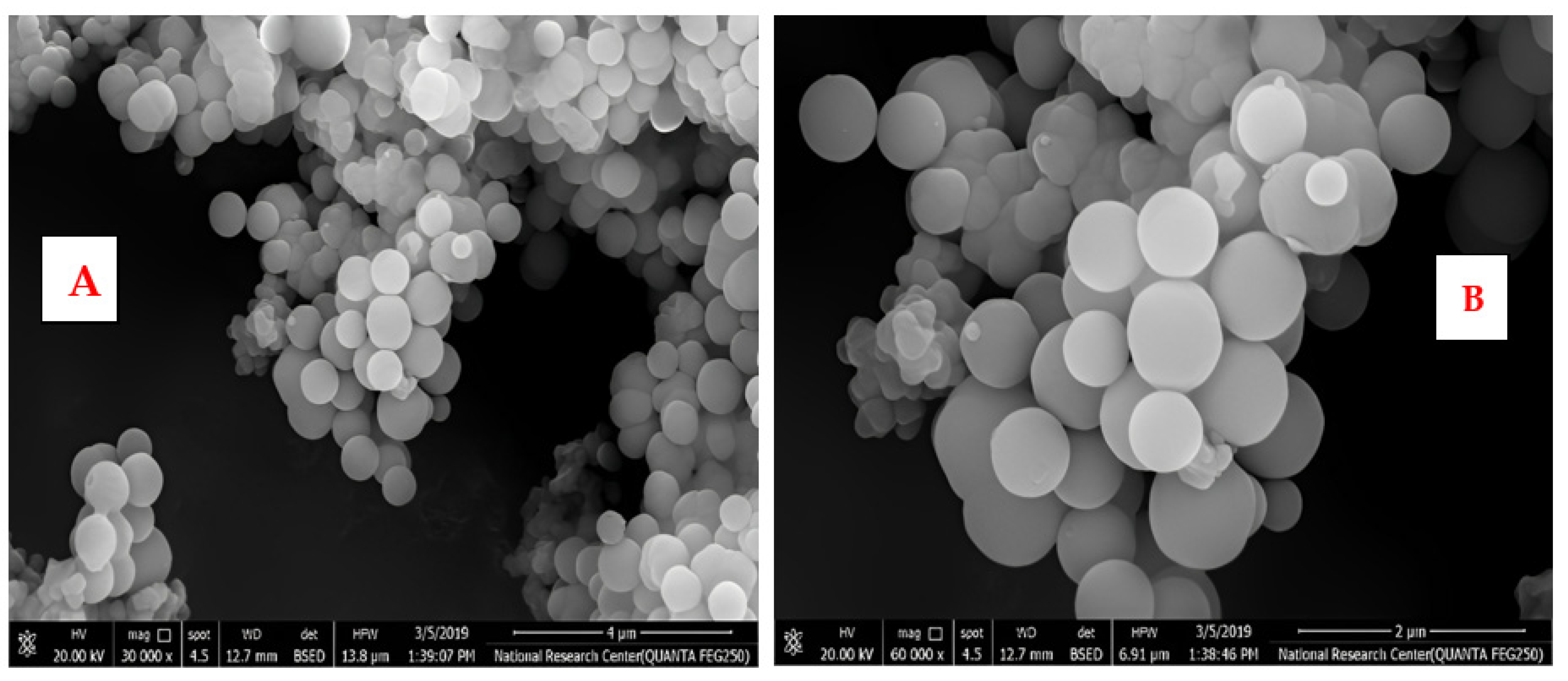
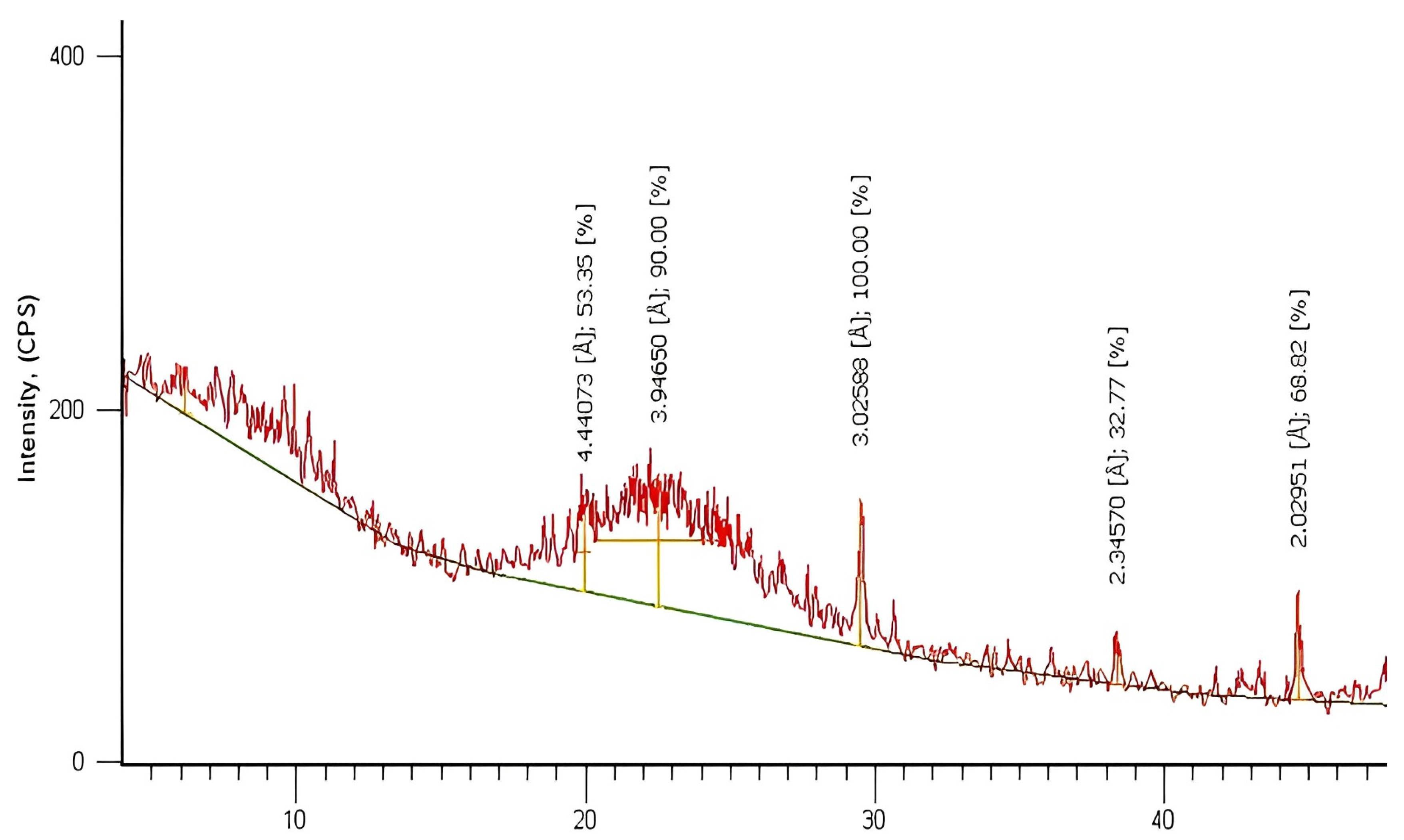
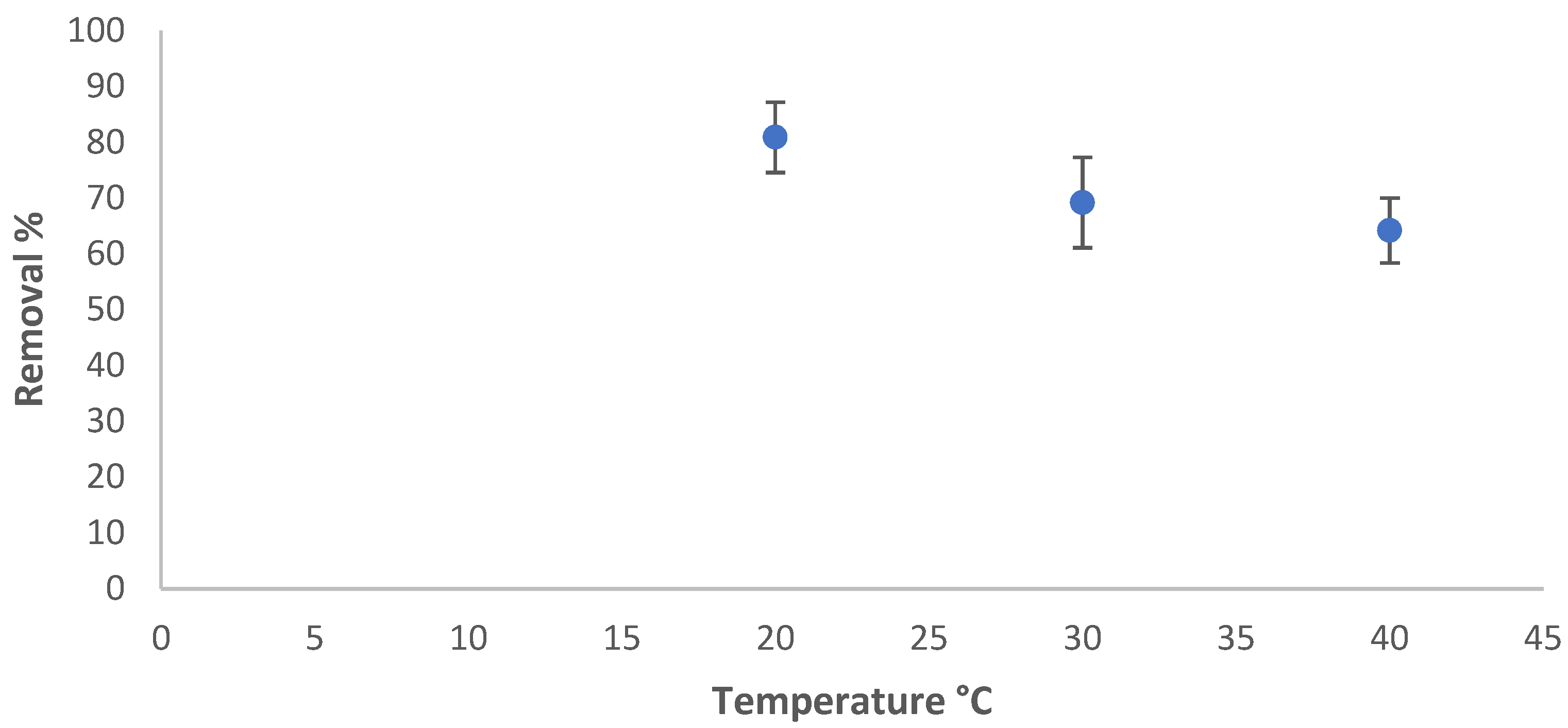
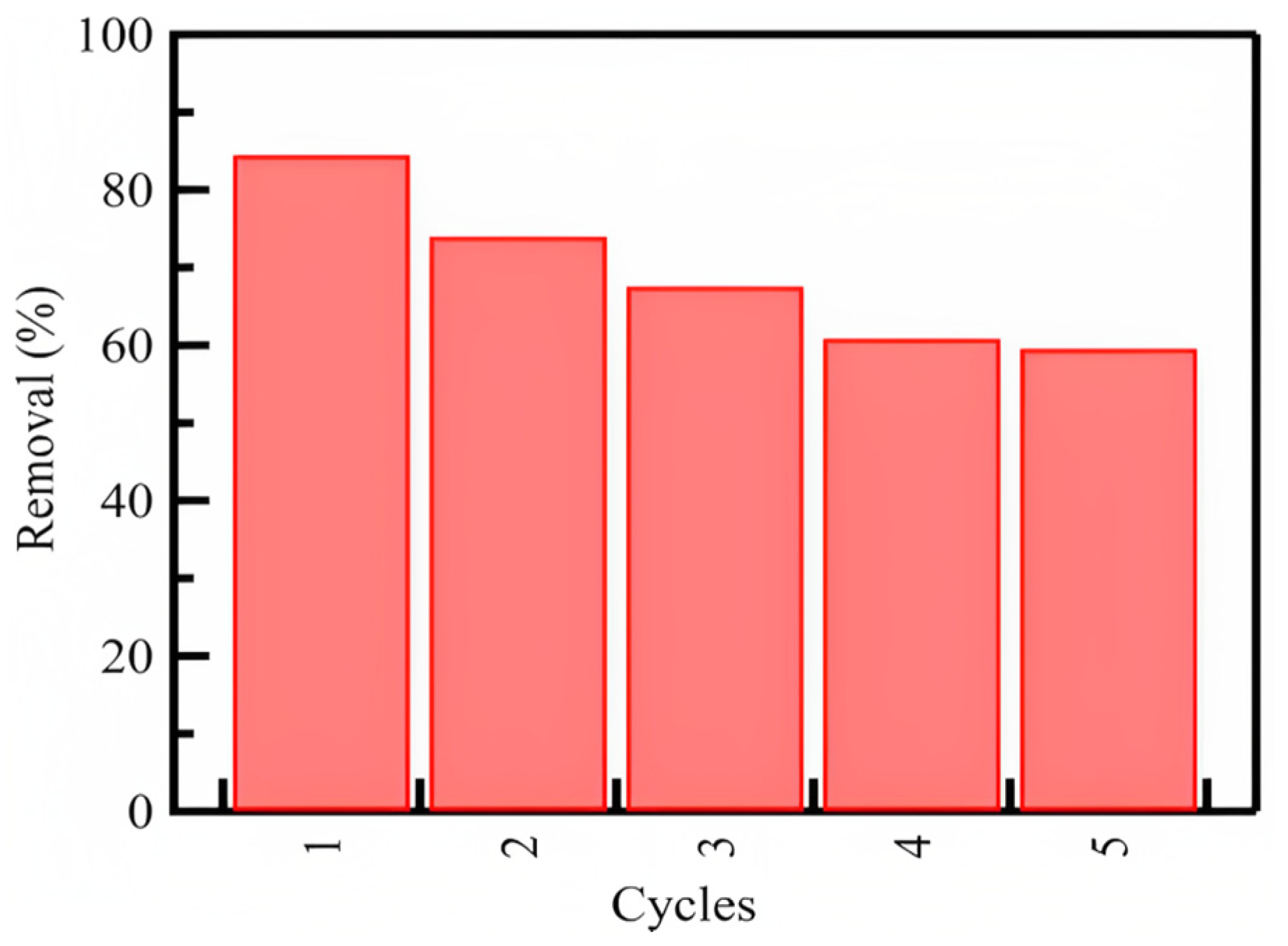
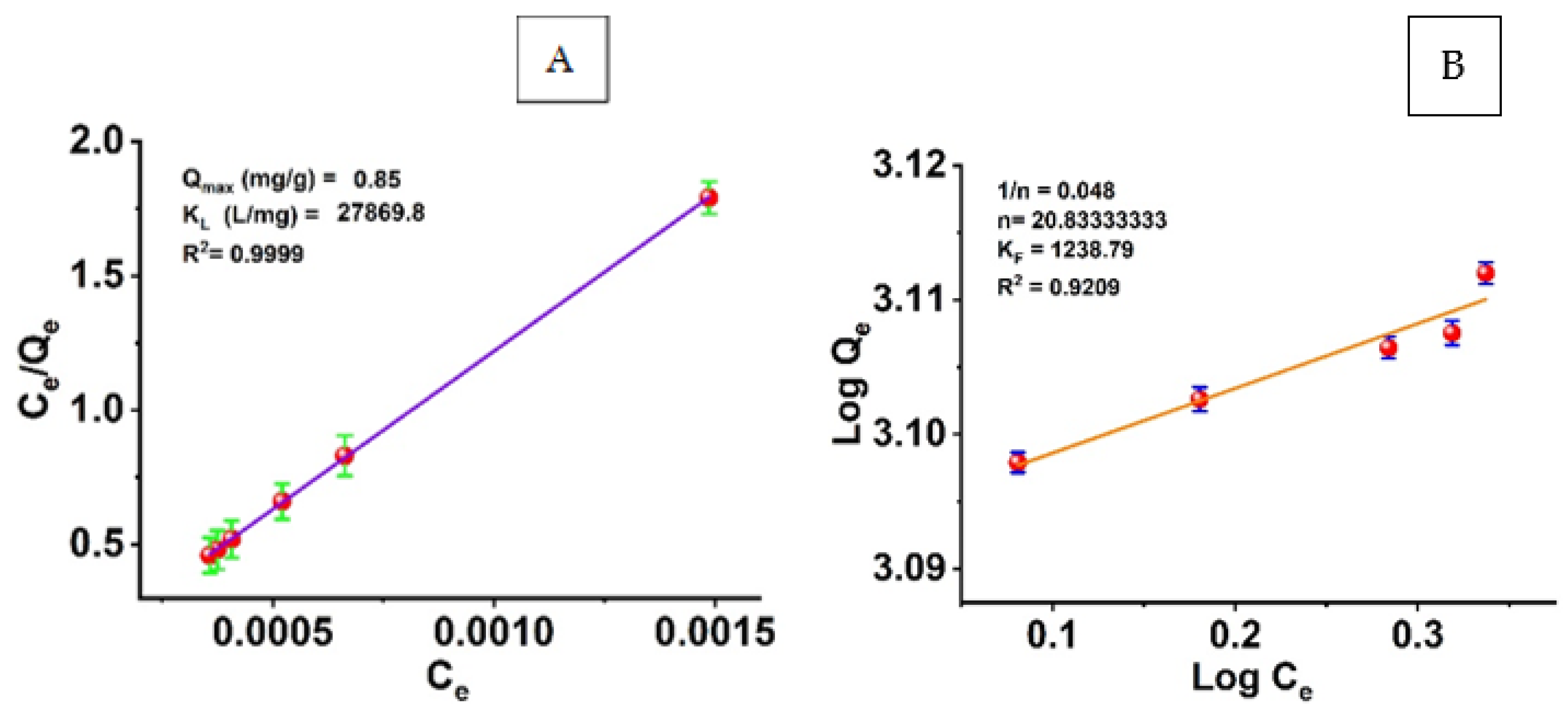

| Mass of Adsorbent (g) | Initial Concentration of Azoxystrobin Co (mg/L) | Residual Concentration Ce (mg/L) | qe (µmol/g−1) | Removal (%) |
|---|---|---|---|---|
| 0.005 | 10 | 4.03 | 4818.9 | 59.7 ± 2.1 |
| 0.01 | 10 | 2.01 | 3223.3 | 79.9 ± 1.7 |
| 0.05 | 10 | 0.49 | 767.3 | 95.1 ± 2.7 |
| 0.1 | 10 | 0.47 | 719.2 | 95.6 ± 3.1 |
| Initial Concentration C0 (mg/L) | Time (h) | Mass of Adsorbent (g) | Residual Concentration Ce (mg/L) | qe (µmol/g) | Removal (%) |
|---|---|---|---|---|---|
| 5 | 0.5 | 0.05 | 0.98 | 324.6 | 80.5 ± 2.4 |
| 5 | 1 | 0.05 | 0.36 | 374.5 | 92.8 ± 2.8 |
| 10 | 0.5 | 0.05 | 3.33 | 538.1 | 66.7 ± 1.3 |
| 10 | 1 | 0.05 | 2.52 | 603.9 | 74.9 ± 1.9 |
| 20 | 0.5 | 0.05 | 9.04 | 1045.1 | 54.8 ± 2.3 |
| 20 | 1 | 0.05 | 6.82 | 901.3 | 65.9 ± 3.7 |
| 40 | 0.5 | 0.05 | 20.24 | 1593.7 | 49.4 ± 3.1 |
| 40 | 1 | 0.05 | 18.64 | 2529.7 | 53.4 ± 4.1 |
| 80 | 0.5 | 0.05 | 44.6 | 2250.8 | 44.25 ± 3.3 |
| 80 | 1 | 0.05 | 39.12 | 25,531.2 | 51.1 ± 3.9 |
| Adsorbent | Pesticide Type | Maximum Adsorption Capacity (mg/g) | References |
|---|---|---|---|
| Phenyl-modified magnetic graphene/ mesoporous silica | Avermectin, Imidacloprid, Pyridaben, Dichlorvos, Acetamiprid, Dursban, Isocarbophos, Phoxim | 9.208 (avermectin); 6.404 (imidacloprid); 12.72 (pyridaben); 47.78 (dichlorvos); 5.108 (acetamiprid); 8.010 (dursban); 2.877 (isocarbophos); 8.233 (phoxim) | [42] |
| Graphene oxide-based silica-coated magnetic nanoparticles functionalized with 2- phenylethylamine | Chloropyriphos, Parathion, Malathion | 25.6 (chloropyriphos); 135 (parathion); 61.9 (malathion) | [43] |
| Surfactant-coated silica nanoparticles | Naphthalene | 11.45 (naphthalene) | [44] |
| Functionalized magnetic nanoparticles | Tetracycline | 39.1 to 666.7 | [45] |
| Functionalized multi-walled carbon nanotube | Malathion | 5.45–17.11 | [46] |
| The nanocomposite of graphene oxide (GO) and iron oxide (Fe3O4) magnetic nanoparticles (MNPs) | Endrin Dieldrin | 99 (endrin); 1 (dieldrin) | [47] |
| Metal-organic framework on graphene oxide | Glyphosate | 482.69 | [48] |
| SiO2-NPs | Azoxystrobin | 0.85 | This study |
Disclaimer/Publisher’s Note: The statements, opinions and data contained in all publications are solely those of the individual author(s) and contributor(s) and not of MDPI and/or the editor(s). MDPI and/or the editor(s) disclaim responsibility for any injury to people or property resulting from any ideas, methods, instructions or products referred to in the content. |
© 2023 by the authors. Licensee MDPI, Basel, Switzerland. This article is an open access article distributed under the terms and conditions of the Creative Commons Attribution (CC BY) license (https://creativecommons.org/licenses/by/4.0/).
Share and Cite
Malhat, F.; Abdallah, O.I.; Hussien, M.; Youssef, A.M.; Alminderej, F.M.; Saleh, S.M. Enhanced Adsorption of Azoxystrobin from Water by As-Prepared Silica Nanoparticles. Coatings 2023, 13, 1286. https://doi.org/10.3390/coatings13071286
Malhat F, Abdallah OI, Hussien M, Youssef AM, Alminderej FM, Saleh SM. Enhanced Adsorption of Azoxystrobin from Water by As-Prepared Silica Nanoparticles. Coatings. 2023; 13(7):1286. https://doi.org/10.3390/coatings13071286
Chicago/Turabian StyleMalhat, Farag, Osama I. Abdallah, Mohamed Hussien, Ahmed M. Youssef, Fahad M. Alminderej, and Sayed M. Saleh. 2023. "Enhanced Adsorption of Azoxystrobin from Water by As-Prepared Silica Nanoparticles" Coatings 13, no. 7: 1286. https://doi.org/10.3390/coatings13071286






